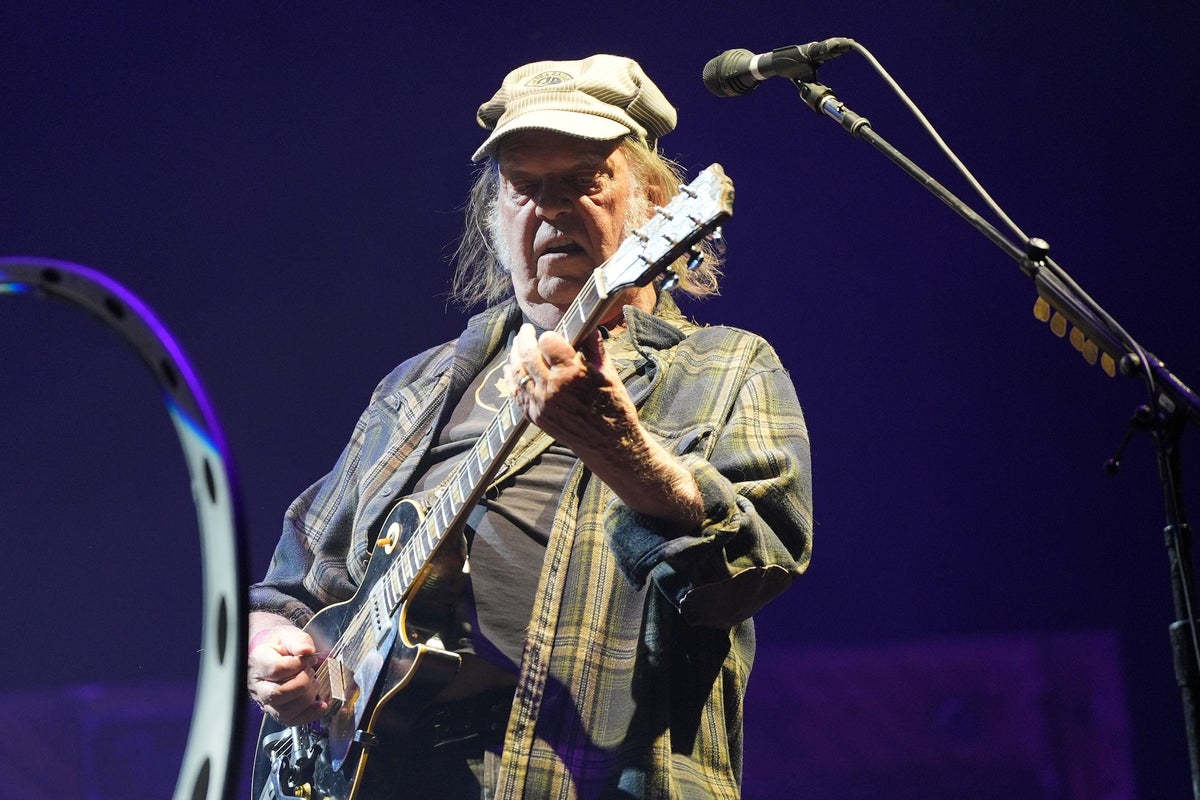And so Neil Young wanders into the wide-angled glare of the Pyramid Stage, blinded by the on-air camera lights, having succumbed to what he previously dubbed the “corporate turn-off” of the modern-day, red-buttonable Glastonbury experience. “How you doing at home in your bedrooms?” he grumps, his stand against the Beebification of the event faltered and his set duly broadcast. But, to be honest, he should be thankful for the additional audience. The Make Everything Pop Again brigade have long argued that Charli XCX should be in this 79-year-old legend’s slot, and you can only concede the point – Young’s Pyramid crowd is as sparse as any headliner’s this writer has seen since Youssou N’ Dour in 1992. As he takes the stage alone, with just a guitar and harmonica and clad in a back-lounge shirt, to strum modestly through 1977’s “Sugar Mountain”, the scene is very much giving mid-afternoon at the Acoustic Stage.
He’s met with no little reverence from the faithful though, and as his Chrome Hearts band join him for a refined churn through the heavyweight grunge country of “Be the Rain”, he undoubtedly still sounds like a bill-topping force. Adding loudhailer yelps through a megatron of a mike stand – numerous effects microphones lined up across a trident of vocal-skewing possibility – he belies any potential accusations of tired old fashion. And the CSNY-style harmonies of “When You Dance, I Can Really Love You” and crunching power rock of “Cinnamon Girl” prove him as capable of thundering through a mighty catalogue as any of Glastonbury’s regular rock greats.
What develops is kind of a gnarled, intense country rock equivalent of Bowie in 2000. Half an hour in, Young is unleashing “Hey Hey, My My (Into the Black)” in the style of a demonic REM, then following it by sitting alone on the drum riser for a vulnerable solo “The Needle and the Damage Done”. In turn, a loping, languid “Harvest Moon” strikes up, a bayou beauty of a song that will make those at Glasto now a-brat think themselves accursed they were not here. It’s perfect crowd-pleasing for Young’s select, blessed crowd.
His idea of a special guest is Hank Williams’s guitar, held aloft at the end of the gorgeous, pastoral CSNY song “Looking Forward”. His pyrotechnics are strictly of the fretboard variety and generally aimed into a circle of bandmates. His headline-catching political soundbites often come buried in narrative and metaphor: witness the harassed protestor of “Sun Green”. But for a man who, on some recent albums, has been in a battle with himself to record the longest song possible, the first hour is remarkably tight, hit-laden and unflabby.
A loose, lumbering, grimy blues segment is more challenging, but Young pulls it back with a spacey and dynamic “Like a Hurricane”, his keyboardist playing a wire-suspended keyboard with black wings. And as he takes to a rustic organ for a frail but sublime “Name of Love”, powers through a cased-in-brimstone “Rockin’ in the Free World” and utilises his watching audience of millions to make a pointedly anti-war, anti-hate and (subliminally) anti-Trump protest statement with “Throw Your Hatred Down”, his original point is wholeheartedly proven.
Glastonbury shouldn’t become all about audience share, televisual spectacle and trend-chasing popularity. It always has, and should always be, about the planet’s best music performed with heart and intensity for anyone who wants to gather to hear it. And by and large, the BBC’s cameras got Neil Young’s best side.

